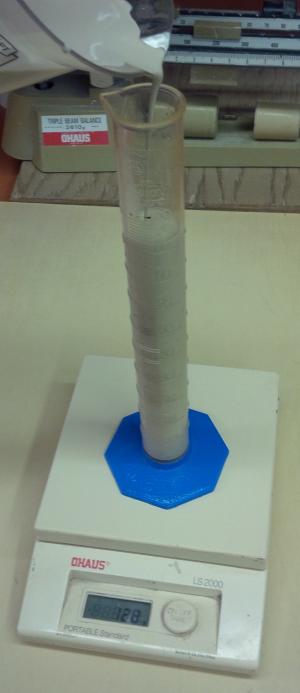| Monthly Tech-Tip | No tracking! No ads! |
Carefully measure specific gravity using a scale and graduated cylinder
This is a convenient way to measure the specific gravity of a glaze or clay slurry fairly accurately. Get a graduated cylinder like this (e.g. Amazon.com). Be careful with cheap plastic ones, check them with water and mark the true 100cc mark if needed. Counterbalance the empty graduated cylinder to zero on your 0.01g scale. Fill it to the 100 mark. The specific gravity is the weight divided by 100.
Related Pictures
Measure specific gravity using a scale and measuring cup

This picture has its own page with more detail, click here to see it.
The specific gravity of a suspension is simply its weight compared to water (water weighs 1g per cc). For example, different glazes optimize to different specific gravities (e.g. 1.45 is typical for stoneware glazes). Casting slips typically have specific gravities of 1.75-1.8. This plastic measuring cup accommodates 500g. I have already counter-weighed it on our 0.1g scale and filled it with 500 grams of water to verify the accuracy of the 500g marking (mark the correct level with a felt pen or sticker if needed). Now, I am filling the cup with the slurry to the same level. The specific gravity is this weight divided by 500.
Quickly measure specific gravity using a scale and graduated cylinder

This picture has its own page with more detail, click here to see it.
Counterbalance a graduated cylinder on a 0.01g scale and pour in some slurry (being careful not to exceed the total weight the scale can handle). Fill it to any level. Divide the weight by the volume. In this case, it weighs 60.6g and the volume is 41. That calculates to about 1.47 specific gravity. The higher it is filled the more accurate the measure will be.
More problems measuring glaze specific gravity using a hydrometer

This picture has its own page with more detail, click here to see it.
Potters sometimes call this a "floating thingy". Maybe, because of the problems it presents, it does not make a big enough impression to remember the name! Because of the length of the hydrometer the only container we have is this graduated cylinder. I have to fill it just the right level so it reads near the top. OK, fine. But the hydrometer needs to bob up and down to find home. However, this glaze has our desired thixotropy, which prevents free movement. OK, I will carefully help it find home by pushing it down a little. But then it doesn’t want to bob back up! Ok, I’ll pull it up ... then is doesn't want to go back down to where it should float. Not great. Next problem: The glaze is opaque, I can’t see the reading. Yikes! A better way would be to throw out the hydrometer and just tare the empty cylinder on a scale, fill it to 100 and read the SG as the weight/100. Or fill it to any mark and divide the weight by that.
Videos
Links
| Glossary |
Rheology
In ceramics, this term refers to the flow and gel properties of a glaze or body suspension (made from water and mineral powders, with possible additives, deflocculants, modifiers). |
| Glossary |
Deflocculation
Deflocculation is the magic behind the ceramic casting process, it enables slurries having impossibly low water contents and ware having amazingly low drying shrinkage |
| Glossary |
Slurry
|
| Glossary |
Thixotropy
Thixotropy is a property of ceramic slurries of high water content. Thixotropic suspensions flow when moving but gel after sitting (for a few moments more depending on application). This phenomenon is helpful in getting even, drip-free glaze coverage. |
| Glossary |
Specific gravity
In ceramics, the specific gravity of slurries tells us their water-to-solids ratio. That ratio is a key indicator of performance and enabler of consistency. |
| Articles |
Understanding the Deflocculation Process in Slip Casting
Understanding the magic of deflocculation and how to measure specific gravity and viscosity, and how to interpret the results of these tests to adjust the slip, these are the key to controlling a casting process. |
Got a Question?
Buy me a coffee and we can talk

https://digitalfire.com, All Rights Reserved
Privacy Policy

